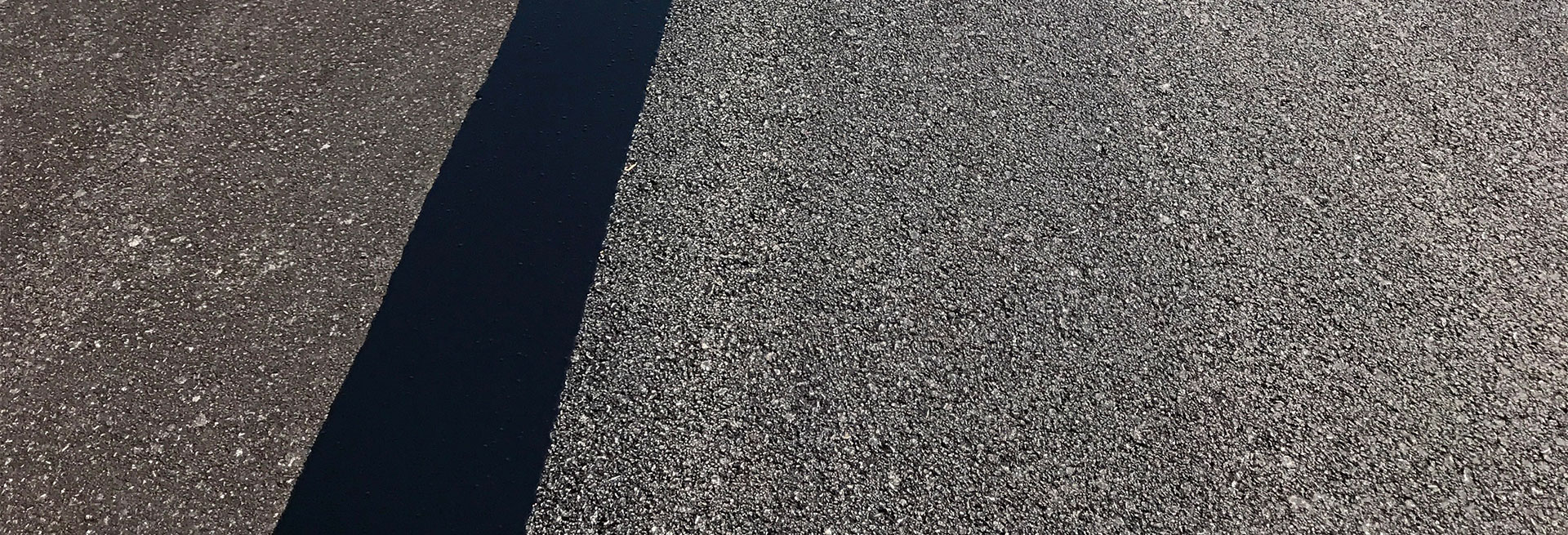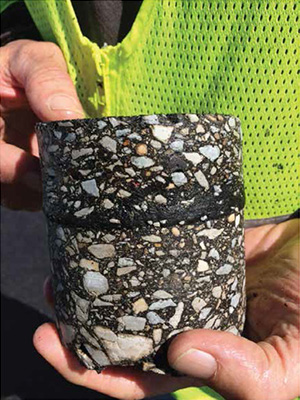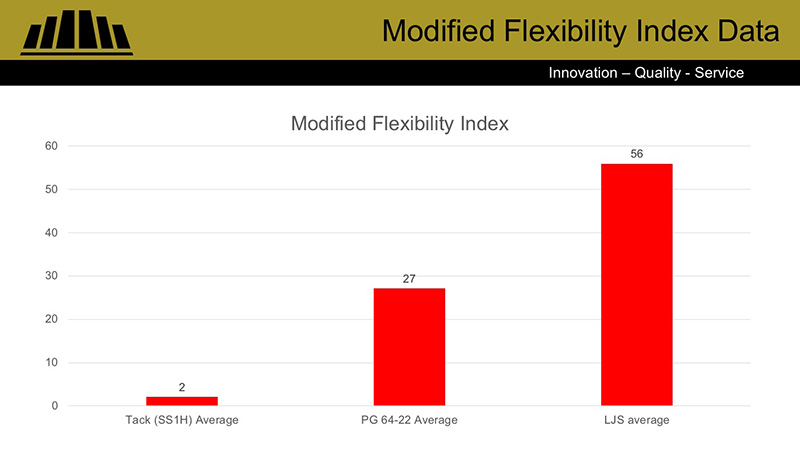THE RESULTS
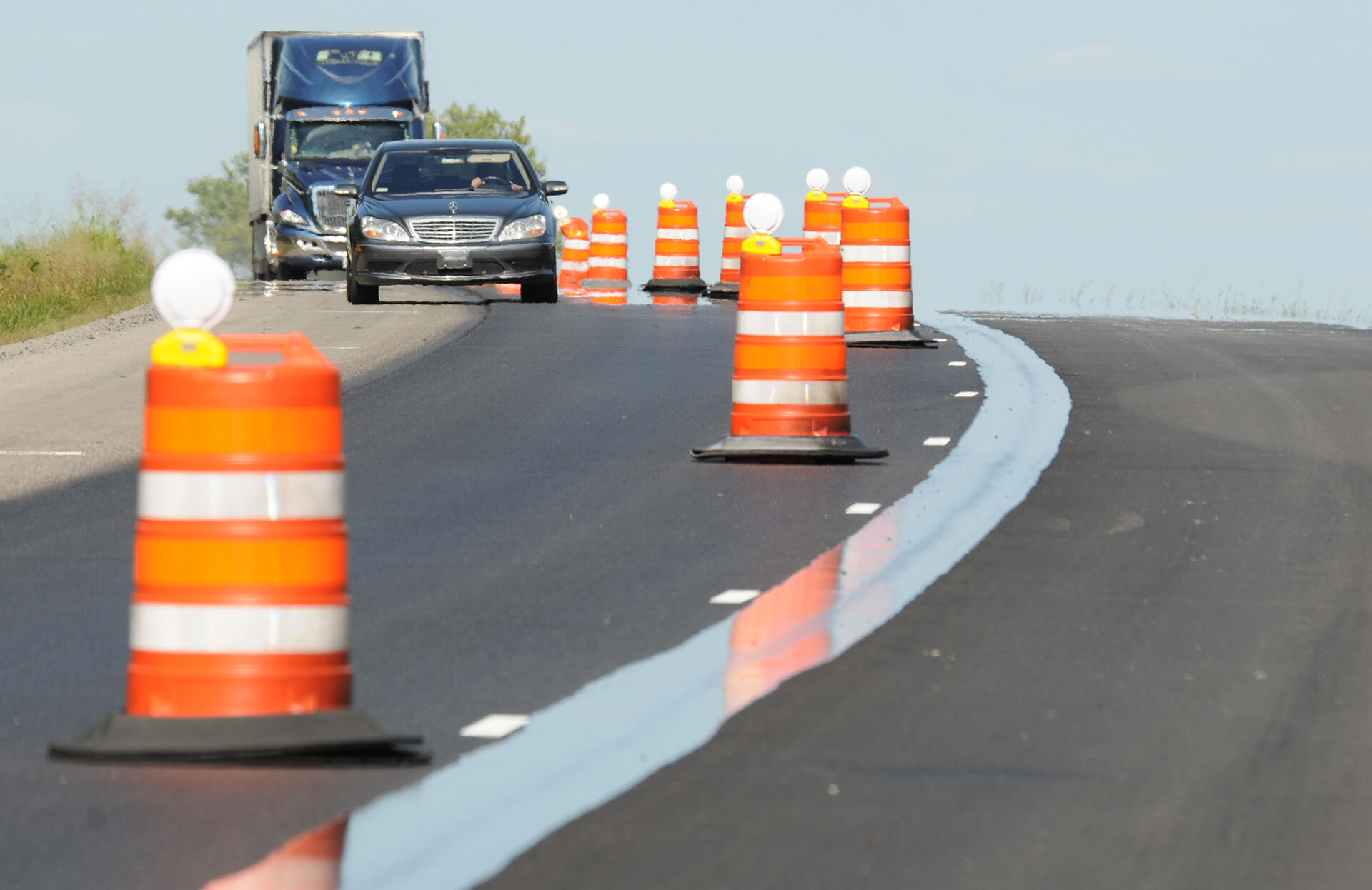
Pave with savings.
J-Band brings more to the table than stronger joints. This game-changing technology helps save three of the most important things to any engineer, applicator, or community: time, money and lives.
Since it’s applied as part of the normal HMA construction process, you don’t need to build in extra time to use J-Band. And motorists in your community won’t be delayed in inconvenient road closures and frustrating traffic congestion.
Using J-Band now paves the way for savings down the road. On the average roadway, every $1 invested in J-Band typically saves agencies $2 in avoided and deferred maintenance costs. This type of investment frees up taxpayer dollars for other important community needs.
Less repair time means less time crews spend on potentially hazardous maintenance or reconstruction. Likewise, motorists in your community will enjoy a safer, more comfortable ride.
Proof already in the pavement.
When you’re in a line of work that demands efficiency and effectiveness, you can’t just cross your fingers and hope a new product works when you use it. J-Band has already proven it can significantly improve pavement performance – it’s been preserving roads across the Midwest for more than 15 years.
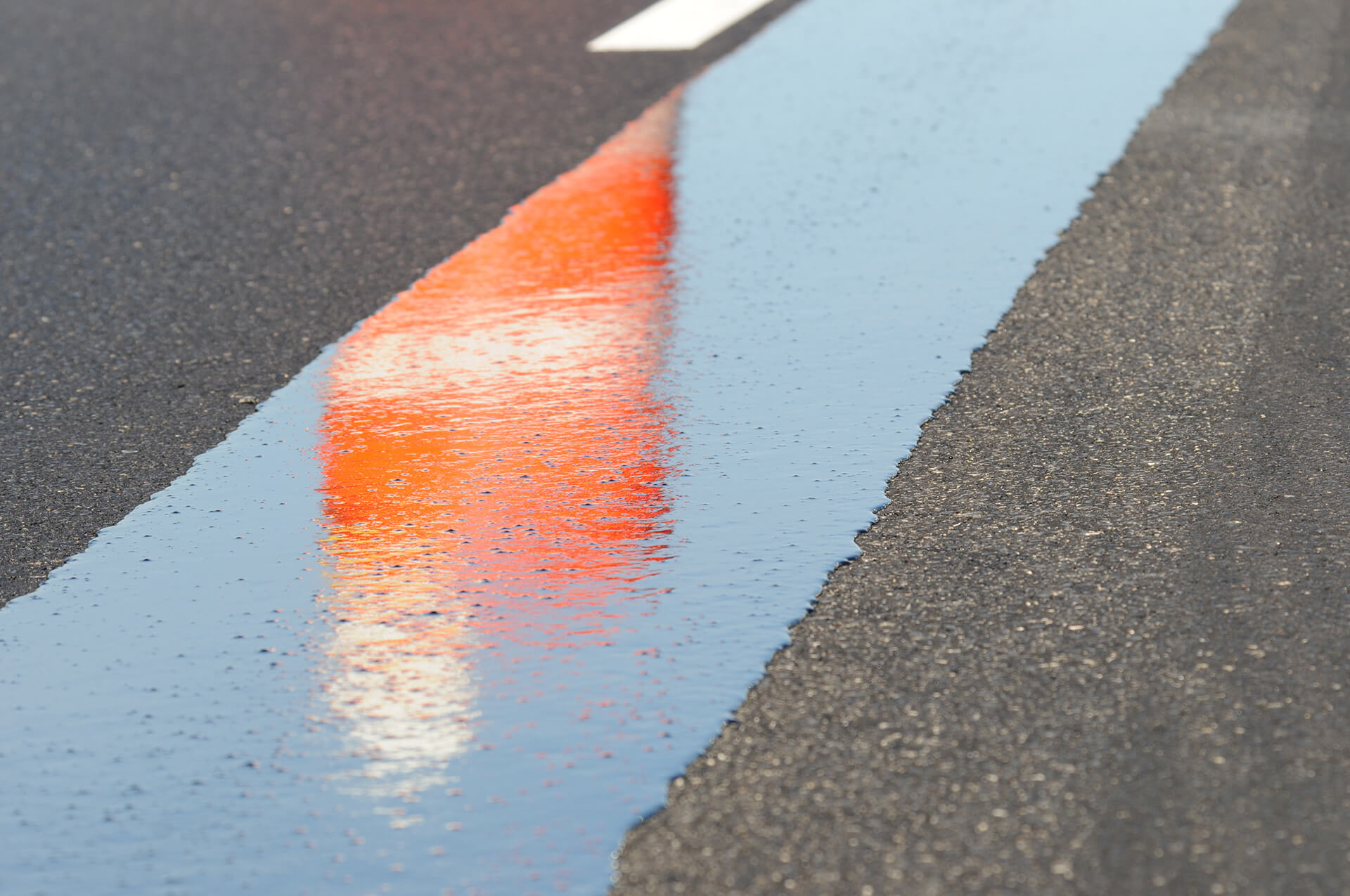
Early J-Band Experiment Project in Macon County, IL
On September 4, 2002 a team from Asphalt Materials, Inc. and Emulsicoat, Inc., in conjunction with the Illinois Department of Transportation, completed a J-Band experiment project on US Route 51 north of Elwin, Illinois. This was one of the first projects J-Band was applied on an open roadway with test and control sections clearly mapped.
Approximately 100 gallons of J-Band was placed using a kettle with specially constructed “strike-off” hand wands to create a 12” and 18” wide strip of material approximately ¼” thick. Four 100-foot test strips were placed on a HMA level binder course below the location of the center line joint in the HMA surface course.
This section of roadway was reviewed by IDOT in the fall of 2017 and the pictures clearly show the outstanding performance of the J-Band as a preventative application for asphalt joint deterioration on a pavement that is 15 years old.
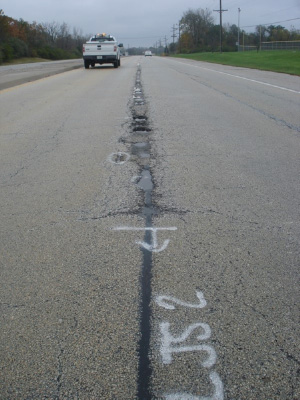
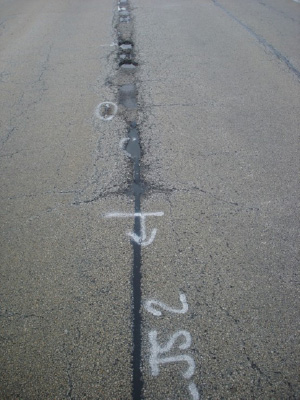
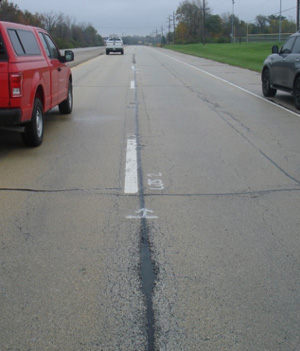
Interstate 77 project in Guernsey County, OH
One of the first J-Band projects in Ohio was constructed in August of 2016 on Interstate Route 77 at the interchange with I-70 in east central Ohio. The project included an application of 18” wide void reducing asphalt membrane (VRAM) between the HMA intermediate and surface courses using J-Band.
Shelly & Sands, Inc. was the prime contractor for the project, and Road Fabrics, Inc. applied the J-Band material supplied by Asphalt Materials, Inc. Approximately 950 gallons of J-Band was applied on 4,975’ of centerline. RFI did an excellent job of applying the material with a consistent width and location. Shelly & Sands paving operation resulted in a properly centered and compacted joint over the J-Band.
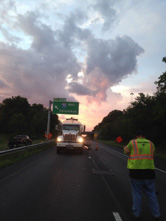
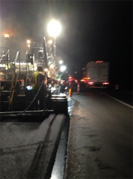
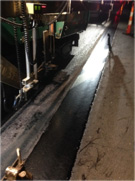
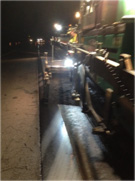
State Road 26 project in Jay County, Indiana
One of the first projects in Indiana that used J-Band was an 8-mile project in east central Indiana is located just west of the Portland, Indiana city limits. Heritage Research Group, Asphalt Materials, Inc., and Milestone Contractors – Richmond Division working in partnership with the Indiana Department of Transportation Central and Greenfield offices selected the project as an opportunity to place and study a void reducing asphalt membrane (VRAM) on the centerline longitudinal joint, and as a hot applied tack coat application using J-Band.
In November of 2016 the application of 450 gallons of J-Band material provided by AMI used as a bonding tack was performed by Illiana Construction, a division of Open Road Paving, LLC on approximately 2,000 feet of a single lane width between the intermediate and surface courses at a rate of 0.15 gallon per square yard. An additional 930 gallons of J-Band was placed 18” wide as VRAM on 4,800 feet of longitudinal centerline joint.
InDOT plans to incorporate cores from the applications into their current studies with the Superpave Research Center at Purdue University pertaining to Longitudinal Joint Construction and Tack Coat Bond/ Fracture Energy Evaluation.
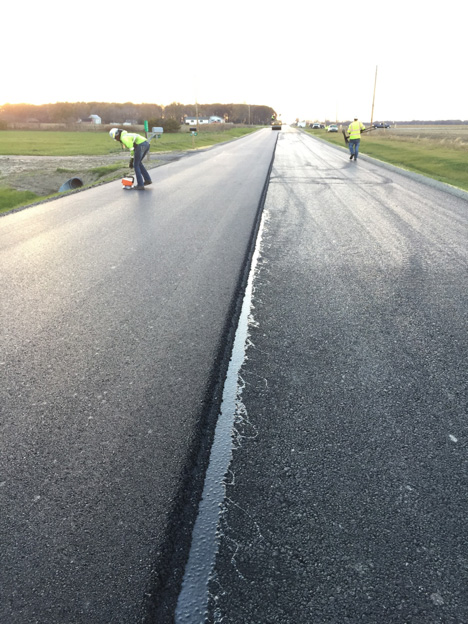
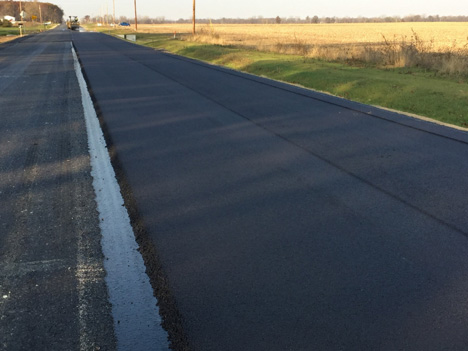
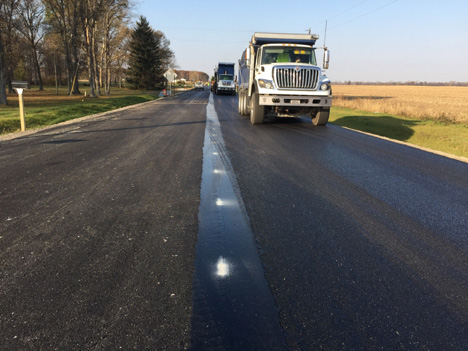
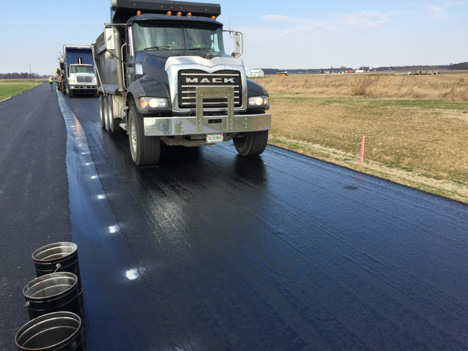
Illinois Route 106 project in Greene County, IL
One of the early applications of J-Band on a milled surface was in the fall of 2016 was an IDOT project on IL 106 in Greene County. The project included an application by Illiana Construction Company of 18” wide longitudinal joint sealant (LJS) between the milled surface and a 2 ¼” surface course using J-Band.
The 2 ¼” thickness of the surface course required a target application rate of 1.96 pounds per lineal foot of J-Band which much heavier than the typical rate for a 1 ½” overlay. This resulted in greater than normal lateral flow of the material, especially in the downhill, super elevated curves. Some minor picking up of the milled surface where it was delaminated was observed but the overall adhesion was very good. Illinois Valley Paving, a division of United Contractors Midwest performed the HMA paving on this project utilizing the “notched wedge” technique. This resulted in a 1” thick, 1’ wide section of mat adjacent to the 2 ¼” mat with the vertical face at the centerline over the middle of the J-Band application.
The Heritage Research Group cored the pavement for the Illinois Department of Transportation after the final surface was placed and those cores show an excellent upward migration and adhesion layer.
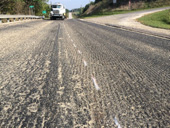
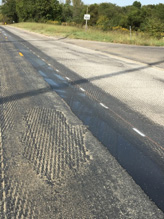
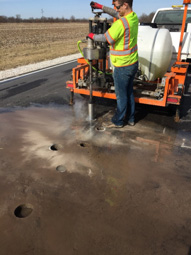
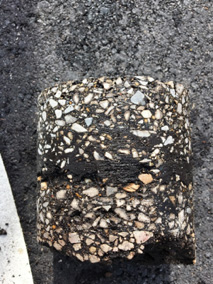
Early J-Band Experiment Project in Macon County, IL
On September 4, 2002 a team from Asphalt Materials, Inc. and Emulsicoat, Inc., in conjunction with the Illinois Department of Transportation, completed a J-Band experiment project on US Route 51 north of Elwin, Illinois. This was one of the first projects J-Band was applied on an open roadway with test and control sections clearly mapped.
Approximately 100 gallons of J-Band was placed using a kettle with specially constructed “strike-off” hand wands to create a 12” and 18” wide strip of material approximately ¼” thick. Four 100-foot test strips were placed on a HMA level binder course below the location of the center line joint in the HMA surface course.
This section of roadway was reviewed by IDOT in the fall of 2017 and the pictures clearly show the outstanding performance of the J-Band as a preventative application for asphalt joint deterioration on a pavement that is 15 years old.



Interstate 77 project in Guernsey County, OH
One of the first J-Band projects in Ohio was constructed in August of 2016 on Interstate Route 77 at the interchange with I-70 in east central Ohio. The project included an application of 18” wide void reducing asphalt membrane (VRAM) between the HMA intermediate and surface courses using J-Band.
Shelly & Sands, Inc. was the prime contractor for the project, and Road Fabrics, Inc. applied the J-Band material supplied by Asphalt Materials, Inc. Approximately 950 gallons of J-Band was applied on 4,975’ of centerline. RFI did an excellent job of applying the material with a consistent width and location. Shelly & Sands paving operation resulted in a properly centered and compacted joint over the J-Band.




State Road 26 project in Jay County, Indiana
One of the first projects in Indiana that used J-Band was an 8-mile project in east central Indiana is located just west of the Portland, Indiana city limits. Heritage Research Group, Asphalt Materials, Inc., and Milestone Contractors – Richmond Division working in partnership with the Indiana Department of Transportation Central and Greenfield offices selected the project as an opportunity to place and study a void reducing asphalt membrane (VRAM) on the centerline longitudinal joint, and as a hot applied tack coat application using J-Band.
In November of 2016 the application of 450 gallons of J-Band material provided by AMI used as a bonding tack was performed by Illiana Construction, a division of Open Road Paving, LLC on approximately 2,000 feet of a single lane width between the intermediate and surface courses at a rate of 0.15 gallon per square yard. An additional 930 gallons of J-Band was placed 18” wide as VRAM on 4,800 feet of longitudinal centerline joint.
InDOT plans to incorporate cores from the applications into their current studies with the Superpave Research Center at Purdue University pertaining to Longitudinal Joint Construction and Tack Coat Bond/ Fracture Energy Evaluation.




Illinois Route 106 project in Greene County, IL
One of the early applications of J-Band on a milled surface was in the fall of 2016 was an IDOT project on IL 106 in Greene County. The project included an application by Illiana Construction Company of 18” wide longitudinal joint sealant (LJS) between the milled surface and a 2 ¼” surface course using J-Band.
The 2 ¼” thickness of the surface course required a target application rate of 1.96 pounds per lineal foot of J-Band which much heavier than the typical rate for a 1 ½” overlay. This resulted in greater than normal lateral flow of the material, especially in the downhill, super elevated curves. Some minor picking up of the milled surface where it was delaminated was observed but the overall adhesion was very good. Illinois Valley Paving, a division of United Contractors Midwest performed the HMA paving on this project utilizing the “notched wedge” technique. This resulted in a 1” thick, 1’ wide section of mat adjacent to the 2 ¼” mat with the vertical face at the centerline over the middle of the J-Band application.
The Heritage Research Group cored the pavement for the Illinois Department of Transportation after the final surface was placed and those cores show an excellent upward migration and adhesion layer.




Innovative to the core.
J-Band’s ability to fill voids in the joint and fend off enemies like air and water are also evident in core samples.
“LJS makes the joint area bullet proof and eliminates future maintenance concerns.”
Illinois Dept. of TransportationEngineer
“Upon completion of the necessary road preparation and required material protocols, the product goes down smooth, thick, and quick, setting up within minutes allowing for immediate road accessibility for traffic and project continuation.”
Illiana ConstructionApplicator
“LJS changes the joint area from being the first thing to become a problem, to being the last.”
Illinois Dept. of TransportationEngineer
“The LJS shadow shines through the final HMA surface indicating heavy joint reinforcement and positive results of the product.”
Open Road PavingPrime Contractor
Raise the bar on the road ahead.
Contact us to learn more about J-Band
